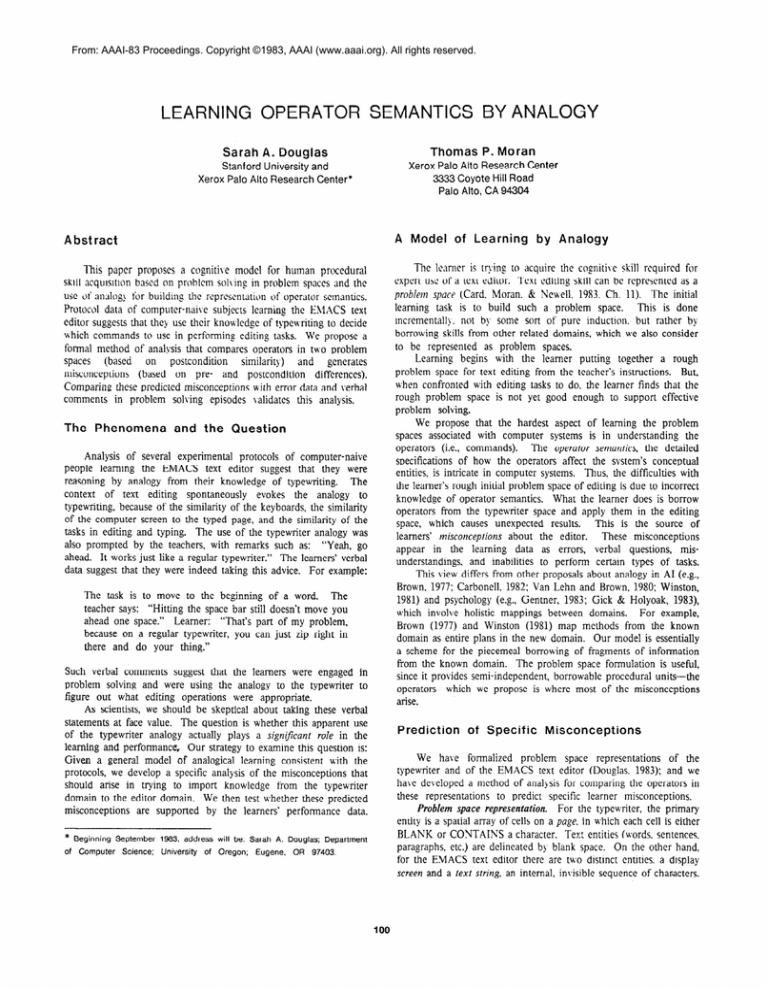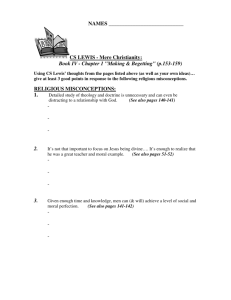
From: AAAI-83 Proceedings. Copyright ©1983, AAAI (www.aaai.org). All rights reserved.
LEARNING
OPERATOR
SEMANTICS
BY ANALOGY
Sarah A. Douglas
Thomas P. Moran
Stanford University and
Xerox Palo Alto Research Center*
Xerox Palo Alto Research Center
3333 Coyote Hill Road
Palo Alto, CA 94304
Abstract
A Model
This paper proposes a cognitive model for human procedural
skill acquisition based on problem sol\ing in problem spaces and the
use or’an&)g! for buildmg the reprcscnration of operator semantics.
Protocol data of computer-naive subjects learning the EhlACS text
editor suaests that they use their knowledge of typewriting to decide
Hhich commands to use in performing editing tasks. We propose a
formal method of analysis that compares operators in two problem
on posrcondirion
similarit))
and generates
spaces (based
misconceptions (based on pre- and postcondition differences).
Comparing these predicted misconceptions bith error data and \.erbal
comments in problem sohing episodes validates this analysis.
The learner is trying to acquire the cngniti\e skill required for
expert ~$2 of a text editor. lext editing skill can be represented as a
probh
space (Card, Moran, & Ncuell, 1983. Ch. 11). The initial
learning task is to build such a problem space. This is done
incrementall!. not by some sort of pure induction. but rather by
borrowing skills from other related domains, which we also consider
to be represented as problem spaces.
Learning begins with the learner putting together a rough
problem space for text editing from the teacher’s instructions. But,
when confronted with editing tasks to do. the learner finds that the
rough problem space is not yet good enough to support effective
problem solving.
We propose that the hardest aspect of learning the problem
spaces associated with computer systems is in understanding the
operators (i.e., commands).
The operaror semantics, the detailed
specifications of how the operators affect the system’s conceptual
entities, is intricate in computer systems. Thus, the difficulties with
the learner‘s rough initial problem space of editing is due to incorrect
knowledge of operator semantics. What the learner does is borrow
operators from the typewriter space and apply them in the editing
This is the source of
space, which causes unexpected results.
learners’ misconceptions about the editor.
These misconceptions
appear in the learning data as errors, verbal questions, misunderstandings, and inabilities to perform certain types of tasks.
This view differs from other proposals about analogy in AI (e.g.,
Brown, 1977: Carbonell. 1982; Van Lehn and Brown, 1980; Winston,
1981) and psychology (e.g., Gentner, 1983; Gick & Holyoak, 1983),
which involve holistic mappings between domains. For example,
Brown (1977) and Winston (1981) map methods from the known
domain as entire plans in the new domain. Our model is essentially
a scheme for the piecemeal borrowing of fragments of information
from the known domain. The problem space formulation is useful,
since it provides semi-independent, borrowable procedural units-the
operators-which
we propose is where most of the misconceptions
arise.
The
Phenomena
and the Question
Analysis of several experimental protocols of computer-naive
people learning the EMACS text editor suggest that they were
reasoning by analogy from their knowledge of typewriting. The
context of text editing spontaneously evokes the analogy to
typewriting, because of the similarity of the keyboards, the similarity
of the computer screen to the typed page, and the similarity of the
tasks in editing and typing. The use of the typewriter analogy was
also prompted by the teachers, with remarks such as: “Yeah, go
ahead. It works just like a regular typewriter.” The learners’ verbal
data suggest that they were indeed taking this advice. For example:
The task is to move to the beginning of a word. The
teacher says: “Hitting the space bar still doesn’t move you
ahead one space.” Learner: “That’s part of my problem,
because on a regular typewriter, you can just zip right in
there and do your thing.”
Such verbal comments suggest that the learners were engaged in
problem solving and were using the analogy to the typewriter to
figure out what editing operations were appropriate.
As scientists, we should be skeptical about taking these verbal
statements at face value. The question is whether this apparent use
of the typewriter analogy actually plays a significanl role in the
learning and performance, Our strategy to examine this question is:
Given a general model of analogical learning consistent with the
protocols, we develop a specific analysis of the misconceptions that
should arise in trying to import knowledge from the typewriter
domain to the editor domain. We then test whether these predicted
misconceptions are supported by the learners’ performance data.
* Beginning
of
Computer
September
Science;
1983,
address
University
of
will
be:
Oregon;
Sarah
A. Douglas;
Eugene,
of?
Prediction
of Learning
of Specific
by Analogy
Misconceptions
We have formalized problem space representations of the
typewriter and of the EMACS text editor (Douglas, 1983); and we
have developed a method of analysis for comparing the operators in
these representations to predict specific learner misconceptions.
Problem space representation. For the typewriter, the primary
entity is a spatial array of cells on a page. in which each cell is either
BLANK or CONTAINS a character. Text entities (words. sentences,
paragraphs, etc.) are delineated b) blank space. On the other hand,
for the EMACS text editor there are two distinct entities. a display
screen and a text wing, an internal, invisible sequence of characters.
Department
97403.
100
Once npcr,ltors have bccr~ matched by similarit!. their predicate
descriptions cdn bc compdrcd for differences in order to gcneratc a
taxonomy of potential misconceptions. As both Halasz and Moran
(1983) and Gentner (1983) have pointed out. the harmfulness of
using ,nlJlog! ,is a rcJching de\ ice is the mabilit! of no\ ices to
distinguish the differences from the similarities. that is. novices tend
to overextend similarities. thus causing misconceptions. There are
two sources of misconceptions when using one operator for another:
(1) unknown preconditions and (2) unknot n postconditions. Figure
2 summarizes these predicted misconceptions. grouped by the
similarity links in Figure 1. These subtle differences are what makes
it difficult to learn by analogy. For example, when the learner
borrows the ADD operator for the INSERT operator. the BLANK
cell precondition comes with the ADD. Thus. we would expect the
learner to try to find or create a blank cell before inserting a
This particular misconception, assuming the BLANK
character.
precondition for inserting. is listed as h48a in Figure 2.
An interesting feature of the similarity comparison between
typewriter and EMACS operators in Figure 1 is that operators are
grouped into two classes: locafive (for moving the pointer around)
and mufafive (for changing text entities). The figure shows that three
locative operators from the typewriter are similar to mutative text
editor operators, which insert formatting characters. Some of the
major misconceptions for the learners involve an “ontological shift”
from locative to mutative operators.
The screen is gcnerared from the text string b! the editor’s
DISPLIZ\’ operation. In addition to text characrcrs. the text string
also contains formatting characters (SPACE-CHAR. RE’IURNCH[\R. and TAB-CHAR) which control where text characters are
displd! cd. lhe formatting chdrditers Jlso occup! sp&J cells on the
screen, but they are invisible. Thus. a blank cell on the screen cm
be either EMPTY’ or contain an lNL’\‘ISIBLE character.
While the screen looks like a typed page to the learner. its
This behavior can be described by
behavior is very different.
comparing operators in the two domains. We represent operators by
For example,
precondition and postcondition state predicates.
consider the typewriter operator for typing a new character on the
page, ADD (Charne, 1:
Preconditions
POINTER-AT (Gem)
BLANK (Cell)
Postconditions
POINTER-AT (NEXT-RIGHT (Cell))
CONTAINS (Cell, Char,,,)
The preconditions are that the typewriter POINTER must be AT a
BLANK cell. The effect of the operator is that the cell CONTAINS
the typed character and the POINTER is moved to the NEXTRIGHT cell. Next, consider the corresponding EMACS operator for
typing a new character, INSERT (Charnew):
Validation
of Predictions
with
Empirical
Data
Our data is taken from the experiments reported by Roberts and
Moran (1983). We use detailed protocol records of the learning
sessions from their EMACS learning experiments.
The experimental teaching paradigm is tutorial, with a single
teacher and a single learner. Interspersed in the paradigm are several
quizzes, during which the learner performed typical editing tasks
without the help of the teacher. We have two kinds of protocol data
to work with--llerbal dura, which was transcribed from audio tape,
and performance data, consisting of computer-collected time-stamped
keystrokes-from which we can see the course of learning in detail.
Perfomance error data. Figure 2 presents the frequency of
learner errors observed in the performance data for the first two
quizzes of the learning sessions. The error data shows that semantic
errors are a significant portion of early skill acquisition (75 out of
105 errors observed). It can be seen that the overall coverage by the
above analysis is good (covering 62 of 75 semantic errors). Errors
involving the “ontological shift” (misconceptions M5 through M7)
are very frequent, accounting for 30 of the observed errors.
Another use of these analyticallyVerbal protocol example.
generated misconceptions is to explain some of the confusions found
in verbal protocols, such as the example at the beginning of this
paper. In this example, the misconception of inserting an invisible
formatting character is evident. The novice uses the space bar to
move across the screen without understanding that she is inseking a
space charucrer into the text string (misconception M5 in Figure 2).
For some reason she forgets to use the text editor command (which
she knows and has used many times before) to move over one
horizontal unit. The effect of inserting invisible characters is very
surprising to her, and she cannot explain why the cursor maintains
the same distance from her target location while moving further to
the right across the screen. She is frustrated in her attempts to “‘just
zip right in there.” This example also illustrates how the interactive
nature of the text editor reduces the credit/blame assignment
problem, since the novice can see the immediate effects of applying
the wrong operator and can localize where to correct the problem.
Preconditions
*SEQUENCE (Chari, Char&
*SELECTED (Char&
POINTER-AT (CeZ$)
Postconditions
*SEQUENCE (Chari, Char,, , Char&
*SELECTED (ChaQ
POINTER-AT (LOCATION-OF (ChaQ)
(DISPLAY (CeZ$, *TEXT-FOLLOWING(Chari))}
(The predicates marked with asterisks refer to the underlying text
string and hence are invisible to the user.) The preconditions for the
EMACS operator are that the editor’s POINTER be positioned AT
the cell containing the character following the new character (i.e., an
“insert before” operator). There is no precondition for blankness.
The effect of the operator is to DISPLAY the new character and to
re-DISPLAY all the TEXT-FOLLOWING it (which can have
complex effects on the screen).
We have in this manner formulated problem spaces for both the
typewriter and for EMACS (see Douglas, 1983, for details).
Comparing similar opemtors.
In the process of trying to
understand E%4ACS operators, the learner borrows typewriter
operators that are similar to the EMACS operators.
We have
developed a method of analysis that uses two criteria of similarity:
(1) surface feature similarity, which in this case is whether the
operators utilize the same keyboard key, and (2) similar effects (e.g.,
postcondition match). Figure 1 shows all the similarity links between
operators.
For example, consider link M8 between the ADD and INSERT
operators (which are described above). The postcondition of ADD is
that a cell CONTAINS the new character. The postcondition of
INSERT has a DISPLAY operation which produces a set of
CONTAINS predications, including one for the new character.
Thus, the postconditions for ADD and INSERT match.
101
TYPEWRITER
KEST-C-ELI, (typc SPACE-BAR)
EMACS
Rll
- 7
\
\
PREY-CELL
(type BS-KEY)
SKIP-TO-NEXT-TAB (type TAB-KEY)
‘-\
RETURN-CARRIAGEc~
(type RETURN-KEY)
\
\
\
\
NFST-CH.\R
(type CONTROL F)
R12
PRE\‘-CH.4R
(type CONTROL B)
\
‘,
\
’ \
‘v
\
’ ‘\
‘, v,
’\ \
\
\
\
’\ \
PREY-LINE
(type CONTROL P)
locative operators
\
\
1
\
\
\
\
ADD( Chmcte~ - T
(type Character)
‘N
\
\
‘Y%
\
mutative
\ ‘\+$
operators
\
INSERT ( Chamctetj
\ “$T
is
’ ‘\
\A \
\
\ L - -INSERT (SPACE-CHAR)
(type SPACE-BAR)
’ ‘1
’
\
’
s
\
’\ L --INSERT
\
(TAB-CHAR)
\
\
\
(type TAB-KEY)
\
\
\
\
\
L - -INSERT (RETURN-CHAR)
\
\
\
(type RETURN-KEY)
\
\
\
L - -INSERT (Text-ctiructe4
(type Text-character)
ERASE-CELL (Cerr)
(use white-out on Cell)-e$T--EZAR
ERASE-PREY-CELL (Cell)
(type CORRECTION-KEY)
Similarity
Links
(Solid lines indicate similar-action
between
(type RUBOUT-KEY)
Figure 1
Typewriter
and EMACS
relations; and dashed lines indicate similar-action
Operators
and same-key relations.)
Conclusions
The use of analogy for teaching has both advantages and
disadvantages. Individual situations must be analyzed to determine
whether the net balance of using an analogy is for the good. In this
paper we have attempted to develop an analysis technique to predict
This operator
the specific effects of using a specific analogy.
mapping technique is a potentially useful design tool for elaborating
the conceptual complexity resulting from the interaction of new
knowledge of a system to be learned with previous knowledge of
other systems.
Our initial observation, that text editor novices rely heavily on
their knowledge of typewriting to understand the semantics of text
editor operators, accounts for learners’ performance errors resulting
from misconceptions and for many confusions found in the verbal
protocols.
We have presented an analysis technique based on
problem spaces for generating a taxonomy of analogical
misconceptions.
The analysis identifies analogous operators by
similarity of postconditions (effects) and predicts misconceptions by
overextending the similarities to other operator postconditions and to
operator preconditions.
102
Predicted
Misconceptions
Frequency
Observed
of
Errors
Rll.
NEXT-CELL I--- NEST-CH.1R
a. Ignorance that NEIIT-CHAR moves by characters, not cells of text string.
M2.
PREY-CELL -1-1PREY-CHAR
a. Ignorance that PREV-CHAR moves by characters, not cells.
M3. NEXT-CELL-BELO\Y ---1NEXT-LINE
a. Ignorance that NEXT-LINE moves by characters and columns, not cells.
M4. RETURN-CARRLIGE ---- NEXT-LINE
a. Ignorance that NEXT-LlNE moves by characters and columns, not cells.
M5. NEXT-CELL ---- INSERT(SP.ICE-CHAR)
a. Ignorance that cell contains an invisible SPACE-CHAR.
M6. SKIP-TO-NEXT-T.4B ---- INSERT(ThB-CH.4R)
a. Ignorance that TAB-CHAR is an invisible character, not a cell.
M7. RETURN-CARRI.4GE ---I INSERT(RETURN-CHAR)
a. Ignorance that RETURN-CHAR is an invisible character, not a cell.
R18. ,4DD( Chamcte~ ---- INSERT( T~xr-ci4amcte~
a. Assumes typewriter precondition BLANK(Cell).
b. Ignorance that postcondition inserts character into string, not cell (i.e. no strikeover).
c. Ignorance that postcondition inserts character in front of currently selected character.
d. Ignorance that postcondition re-displays text to the right of the insertion point.
M9. ER.4SE-CELL ---I DELETE-CHAR
a. Assumes typewriter precondition CONTAINS(Cell, Charac&r).
b. Assumes typewriter postcondition BLANK(Cell) instead of re-displaying text string.
MlO. ER.ISE-CELL ---- DELETE-PREY-CHAR
a. Assumes typewriter precondition CONTAINS(Cel1, Character).
b. Assumes typewriter postcondition BLANK(Cell).
c. Ignorance that postcondition deletes character in front of currently selected character.
Ml 1. ER.4SE-PREV-CELL ---- DELETE-PREY-CHAR
a. Assumes typewriter precondition CONTAINS(Cel2, Charac1er).
b. Assumes typewriter postcondition BLANK(CeZl).
6
1
7
4
19
9
2
4
3
7
-
Observed errors covered by the predicted misconceptions:
62
Other observed semantic errors not covered by the predicted misconceptions:
Observed syntactic errors (not colered by the predicted misconceptions):
Obsened typing errors (not corered by the predicted misconceptions):
‘13
28
2
Figure 2
Predicted
Misconceptions
and Frequency of Observed
Performance
Errors for Four EMACS Learners
References
Brown, R. Use of analogy IO achieve new expertise (AI-TR-403).
Boston. MA: MIT, Artificial Intelligence Lab, 1977.
Gick, M.L. & Holyoak. K.J. Schema induction and analogical
transfer. Cognitive Psychology, 1983, 15, l-38.
Carbonell, J . Learning by analogy: Formulating and generalizing
plans from past experience. In R.S. Michalski, J.G. Carbonell,
& T.M. Mitchell (Eds.), Machine Learning.
Palo Alto, CA:
Tioga Publishing Co., 1982.
Halasz,
acquisifion.
Learning
to text edit: Semantics
in procedural
& Moran,
T. P.
of
Human
the
Gaithersburg,
Analogy considered
Facrors
in
Computer
harmful.
Systems
MD. March 1517, 1982.
Roberts, T. R., & Moran, T. P. Learning and reasoning by analogy.
Communications of the AChl, 1983, 25, 265-283.
Card, S. K., Moran, T. P., & Newell, A. The psychology of humancomputer interaction
Hillsdale, N.J.: Erlbaum, (1983).
Douglas, S. A.
F.,
Proceedings
Conference,
VanLehn, K., & Brown, J. S. Planning nets: A representation for
formalizing analogies and semantic models of procedural skills.
In R.E. Snow, P. Federico. & W.E. Montague (Eds.), Aprifude,
learning, and inslruction, Vol. 1. Hillsdale, N.J.: Erlbaum, 1980.
skill
Ph.D. dissertation, Stanford University, 1983.
Gentner, D. The structure of analogical models in science. In D.
Gentner and A. S. Stevens (Eds.) h!entaZ models, Hillsdale, N.J.:
Erlbaum, 1983.
Winston, P. Learning and reasoning by analogy. Communications
the ACM, 1981, 23, 689-703.
103
of




